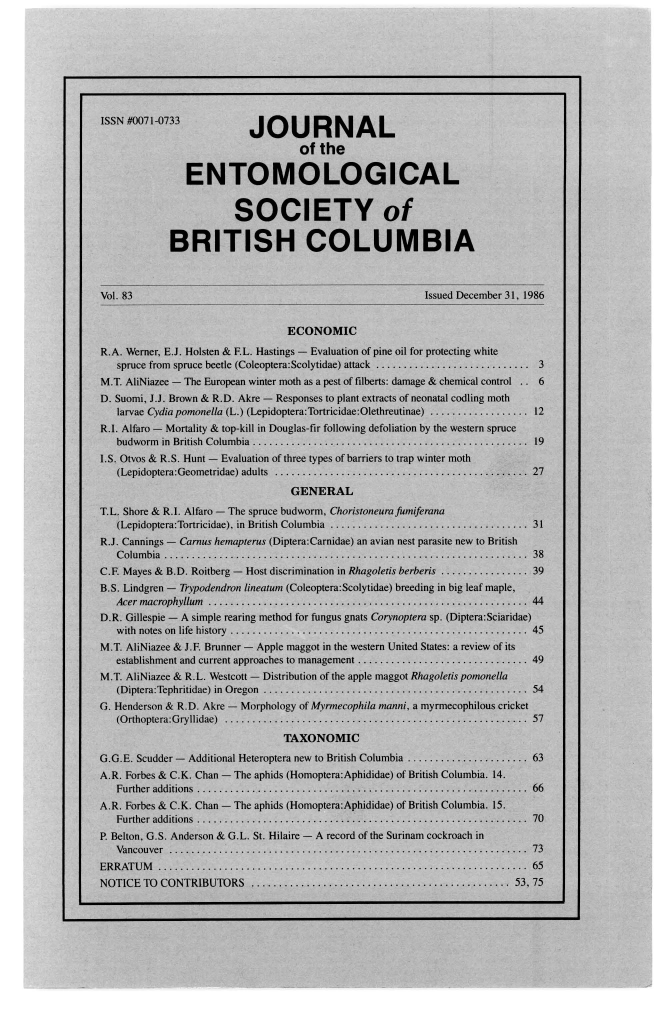Morphology of <i>Myrmecophila manni</i>, a myrmecophilous cricket (Orthoptera: Gryllidae)
Keywords:
<i>Myrmecophila manni</i>, Orthoptera, GryllidaeAbstract
Scanning electron microscopy showed that the myrmecophilous cricket, <i>Myrmecophila manni</i> Schimmer, retains many structural features common to typical gryllids and has few of the morphological features often associated with myrmecophily. However, the mouth parts, particularly the labrum and epipharynx, are highly modified for strigilation and trophallaxis. The structure of the ovipositor is unique in that it can expand greatly to permit the passage of large eggs. This cricket also differs from typical gryllids in having stemmata instead of compound eyes, a feature probably related to its life inside dark ant nests where it does not need good vision. Behavioral, rather than morphological, attributes are probably more important in adapting the crickets for life with ants.
References
Akre, R.D. 1968. The behavior of Euxenister and Pulvinister, histerid beetles associated with army ants (Formicidae: Ecitonini). Pan-Pac Ent. 44:87-101.
Akre, R.D. and Wm. B. Hill. 1973. Behavior of Adranes taylori, a myrmecophilous beetle associated with Lasius sitkaensis in the Pacific Northwest. (Coleoptera: Pselaphidae: Hymenoptera, Formicidae). J. Kansas Ent. Soc. 46:526-536.
Alexander, R.D. 1961. Aggressiveness, territoriality and sexual behavior in field crickets (Orthoptera: Gryllidae). Behaviour 17:130-225.
Bishof, H.F. 1974. The club-shaped sensilla on the cerci of Gryllus bimaculatus as gravity receptors (Orth. Gryllidae). J.Comp. Physiol. 98:277-288.
Dethier, V.G. 1943. The dioptric apparatus of lateral ocelli. I. Visual capacities of the ocellus. J. Cell. Comp. Physiol. 22:115-126.
Gorokhov, A.V. 1982. Morphological peculiarities of crickets of the genera Myrmecophilus Berth. and Eremogryllodes Chop. and systematic position of the tribe Bothriopylacini (Orthoptera, Gryllidae). Entomol. Obozr. 59:287-293.
Haskell, P.T. 1960. The sensory equipment of the migratory locust. Symp. Zool. Soc. Lond. 3:1-23.
Haskell, P.T. 1961. Insects sounds. H.F. and G. Witherby, London. 189 pp.
Hebard, M. 1920. A revision of North American species of the genus Myrmecophila (Orthoptera: Gryllidae; Myrmecophilinae). Trans. Am. Entomol. Soc. 49:91-111.
Henderson, G. 1985. The Biology of Myrmecophila manni Schimmer (Orthoptera: Gryllidae). M.S. Thesis, Washington State University. 83 pp.
Meyer-Rochow, V.B. 1974. Structure and function of the larval eye of the sawfly, Perga. J. Insect Physiol. 20:1565-1591.
Rettenmeyer, C.W. 1961. Arthropods associated with Neotropical army ants with a review of the behavior of these ants (Arthropoda: Formicidae: Dorylinae). Ph.D. Dissertation, Univ. Kansas. 605 pp.
Schimmer, F. 1909. Beitrag zu ciner Monographie der Gryllodeengatung Myrmecophila Latr. Zeitschr. Wissensch. Zool. 93:409-534.
Steiner, A.L. 1968. Behavioral interactions between Liris nigra Van Der Linder (Hymenoptera: Sphecidae) and Gryllus domesticus L. (Orthoptera: Gryllidae). Psyche 75:256-273.
Vander Meer, R.K. and D.P. Wojcik 1982. Chemical mimicry in the myrmecophilous beetle Myrmecaphodius excavaticollis. Science 218:806-808.
Wheeler, W.M. 1900. The habits of Myrmecophila nebrascensis Brunner. Psyche 9:111-115.
Wilson, E.O. 1971. The insect societies. Belknap/Harvard, Cambridge, MA. 548 pp.
Downloads
Published
Issue
Section
License
Authors who publish with the Journal of the Entomological Society of British Columbia agree to the following terms:
-Authors retain copyright and grant the journal right of first publication with the work simultaneously licensed under a Creative Commons Attribution License that allows others to share the work with an acknowledgement of the work's authorship and initial publication in this journal.
-Authors are able to enter into separate, additional contractual arrangements for the non-exclusive distribution of the journal's published version of the work (e.g., post it to an institutional repository or publish it in a book), with an acknowledgement of its initial publication in this journal.
-Authors are permitted and encouraged to post their work online (e.g., in institutional repositories or on their website) prior to and during the submission process, as it can lead to productive exchanges, as well as earlier and greater citation of published work (See The Effect of Open Access).


